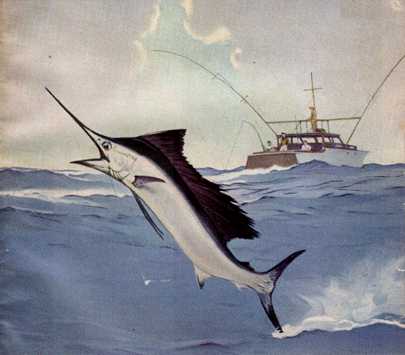|
| 질의: scomber scomber | 결과: 73번째/86 | |
Indo-Pacific sailfish, Istiophorus platypterus, drawing
| 제목: | Indo-Pacific sailfish, Istiophorus platypterus, drawing
| |

| 해상도: 405x355
파일크기: 14160 Bytes
등록시간: 2007:08:16 14:58:32
|
ERROR : Server Busy(-1105)
ERROR : Server Busy(-1105)
Indo-Pacific sailfish, Istiophorus platypterus, drawing
From: "seph"
Newsgroups: alt.binaries.pictures.animals
Subject: Animal Art... Aquatic... 7-color... jpg format...
Date: 4 Oct 1997 18:09:35 GMT
seph...
--
"There are those who age with Wisdom; while others merely get Old"...
Worasan...
Anmaq086.jpg
Comments
========
From: barney.cobil@gte.net
Date: Tue Oct 26 15:09:13 KST 1999
File To Comment: animal5/Anmaq086-Painting-BlueMarlin.jpg
This fish should be identified as a - SAIL FISH
class - Osteichthyes
order - Perciformes
family - Istiophoridae
genus & species - Istiophorus platypterus
"pacific sailfish"...
According to Funk & Wagnalls Illus. Animal Encyclopedia
there is only one species of sail fish found in all tropical waters.
|
댓글 |
|---|
| | 손님 |
|
Scientific Name: Istiophorus platypterus (Shaw, 1792)
Common Names:
English – Sailfish, Indo-Pacific Sailfish, Atlantic Sailfish
Spanish – Aguja de Abanico , Pez Velo, Picudo Banderón
French – Espadon Voilier, Empereur Éventail
Synonyms:
Histiophorus americanus Cuvier,1832
Histiophorus ancipitirostris Cuvier, 1832
Histiophorus dubius Bleeker, 1872
Histiophorus gracilirostris Cuvier, 1832
Histiophorus granulifer Castelnau, 1861
Histiophorus immaculatus Rüppell, 1830
Histiophorus indicus Cuvier, 1832
Histiophorus magnioci Jordan, 1927
Histiophorus orientalis Temminck & Schlegel, 1844
Histiophorus pulchellus Cuvier, 1832
Istiophorus amarui Curtiss, 1944
Istiophorus brookei Fowler, 1933
Istiophorus eriquius Jordan, 1926
Istiophorus gladifer Lacepède, 1801
Istiophorus greyi Jordan & Evermann, 1926
Istiophorus japonicus Jordan & Thompson, 1914
Istiophorus ludibundus Whitley, 1933
Istiophorus maguirei Jordan & Evermann, 1926
Istiophorus triactis Klunzinger, 1871
Istiophorus wrighti Jordan & Evermann, 1926
Makaira albicans Latreille, 1804
Makaira velifera Cuvier, 1832
Scomber gladius Bloch, 1793
Skeponopodus guebucu Nardo, 1833
Xiphias platypterus Shaw, 1792
Xiphias velifer Bloch & Schneider, 1801 |
^o^
동물그림창고 똑똑전화 누리집
^o^
|
|
|